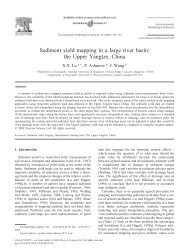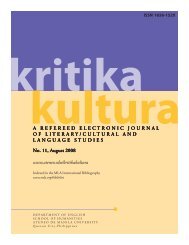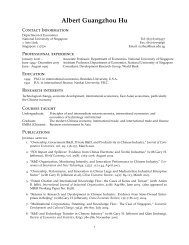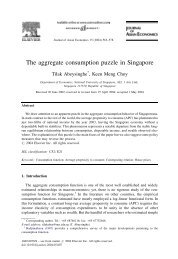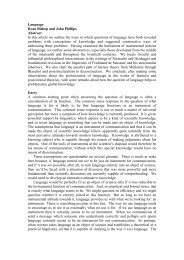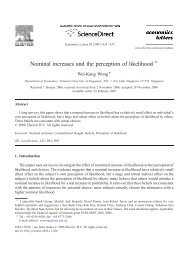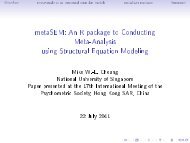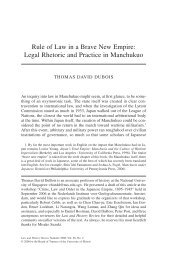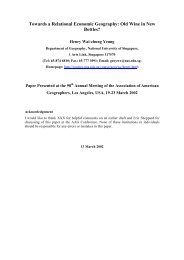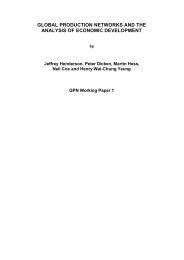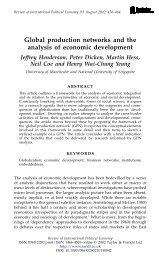Researching Hybridity in Social and Economic ... - NUS Home
Researching Hybridity in Social and Economic ... - NUS Home
Researching Hybridity in Social and Economic ... - NUS Home
Create successful ePaper yourself
Turn your PDF publications into a flip-book with our unique Google optimized e-Paper software.
Carney <strong>and</strong> Gedajlovic, 2002). A straightforward quantitative analysis of Ch<strong>in</strong>ese family<br />
firms is unable to unravel the complex <strong>in</strong>terconnections between the family, the firm, <strong>and</strong><br />
bus<strong>in</strong>ess networks, let alone the material <strong>and</strong> discursive contexts <strong>in</strong> which they are<br />
constructed. Here, my methodological <strong>in</strong>st<strong>in</strong>cts were much <strong>in</strong>fluenced by the methodology of<br />
trac<strong>in</strong>g actor-specific network relations <strong>in</strong> actor network theory – an <strong>in</strong>fluential perspective <strong>in</strong><br />
the study of sociology of science popularized by Michel Callon, Bruno Latour, John Law <strong>and</strong><br />
others (see more methodological discussion on this <strong>in</strong> the next section).<br />
Of course, one might question whether there is anyth<strong>in</strong>g uniquely Ch<strong>in</strong>ese about<br />
Ch<strong>in</strong>ese capitalism, <strong>and</strong> even if there is, why we should study Ch<strong>in</strong>ese capitalism <strong>in</strong> the first<br />
place. These questions raise another methodological issue that is synonymous with the<br />
“cultural turn” <strong>in</strong> economic geography of the late 1990s – the identities <strong>and</strong> ethnicity of actors<br />
<strong>in</strong> Ch<strong>in</strong>ese capitalism. Dirlik (1997), Ong (1993; 1997) <strong>and</strong> Yao (1997; 2002), for example,<br />
argue that much of the methodological problem <strong>in</strong> exist<strong>in</strong>g studies of Ch<strong>in</strong>ese capitalism is<br />
l<strong>in</strong>ked to the romanticization of “Ch<strong>in</strong>eseness” <strong>and</strong> the discursive constructions of Ch<strong>in</strong>ese<br />
capitalism as an object, an ideational construct, <strong>and</strong> a moment <strong>in</strong> the wider hegemonic<br />
discourses on global capitalism. The methodological implication is that we need to<br />
deconstruct these shift<strong>in</strong>g identities <strong>and</strong> ethnicity of actors – both ethnic Ch<strong>in</strong>ese <strong>and</strong> non-<br />
Ch<strong>in</strong>ese – <strong>in</strong> Ch<strong>in</strong>ese capitalism <strong>and</strong> to exam<strong>in</strong>e the powerful effects of discourses on them.<br />
For example, Kong’s (1999) study of S<strong>in</strong>gaporean transmigration <strong>in</strong> Ch<strong>in</strong>a has shown how the<br />
national identity of S<strong>in</strong>gaporeans (as S<strong>in</strong>gaporean Ch<strong>in</strong>ese) was reimag<strong>in</strong>ed <strong>and</strong> negotiated<br />
when they were confronted with their ethnic identity as Ch<strong>in</strong>ese (<strong>in</strong> Ch<strong>in</strong>a). Similar<br />
confrontation <strong>and</strong> negotiations of national identities <strong>and</strong> Ch<strong>in</strong>ese ethnicity can be observed<br />
among the “Overseas Ch<strong>in</strong>ese” <strong>in</strong> Southeast Asia, Europe, <strong>and</strong> North America (see Yeung <strong>and</strong><br />
Olds, 2000). Given this transnational fluidity <strong>in</strong> hybridiz<strong>in</strong>g Ch<strong>in</strong>ese identities, it becomes<br />
methodologically imperative to exam<strong>in</strong>e not only ethnic Ch<strong>in</strong>ese actors, but also non-ethnic<br />
15



